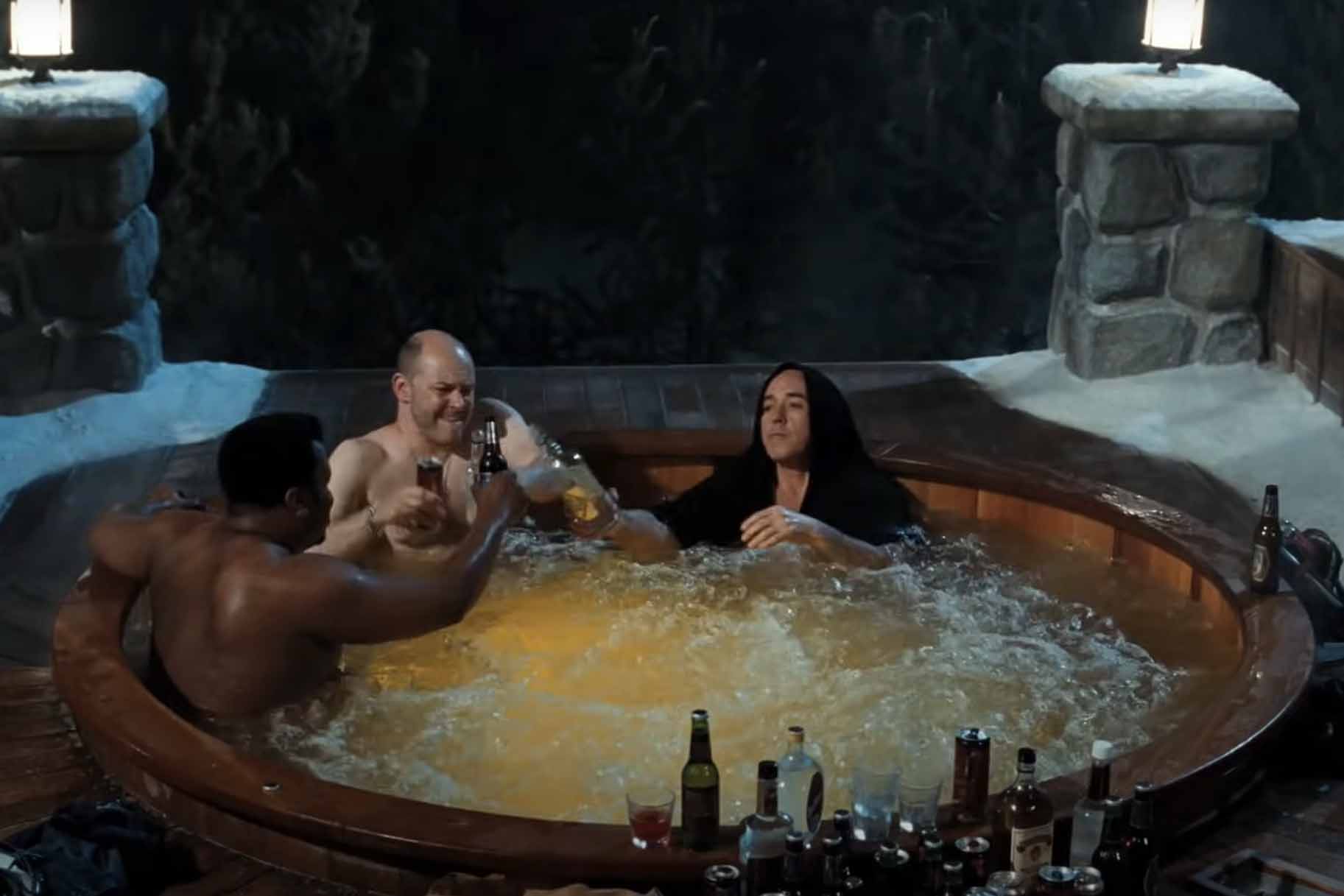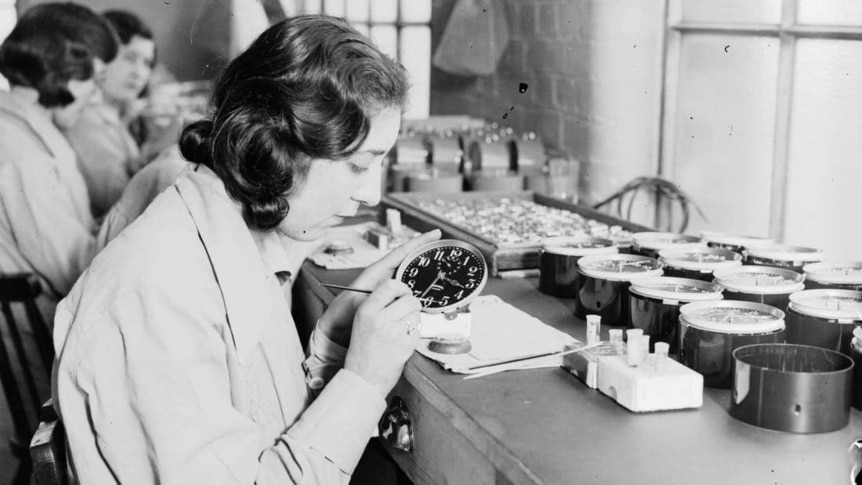Create a free profile to get unlimited access to exclusive videos, sweepstakes, and more!
Real Life Chernobly: When Energy Drinks Were Radioactive
Hot Tub Time Machine's Chernobly was a joke, but in the early 20th century, radioactive energy drinks really existed.

In 2010, three friends attempted (and succeeded) to recapture their youth on a nostalgia-fueled trip to the fictional ski town of Kodiak Valley in Hot Tub Time Machine (now streaming on Peacock). Adam, Lou, and Nick (John Cusack, Rob Corddry, and Craig Robinson, respectively) along with Adam’s nephew Jacob (Clark Duke) settle in at a dilapidated resort hotel, with a hot tub in a serious state of disrepair, for a weekend of certain disappointment.
When the hot tub is suddenly fixed, the four of them party down a little too hard with a bit (way) too much booze and a mysterious Russian energy drink called “Chernobly.” Details about the imported beverage are scant, Lou describes it as a “Russian Red Bull” and claims it has stuff in it that’s “not even legal here.” It’s unclear what that stuff is, but when it spills on the hot tub’s controls, the four of them unwittingly end up a few decades in the past.
The intentionally Soviet-sounding name and the time travel consequences of the drink conjure images of glowing chemicals spitting out radioactivity just inside the thin, aluminum can. The notion of a radioactive energy drink sounds like pure madness, or a Hollywood invention, but about a hundred years ago they were all the rage.
For More on Radiation:
NASA Just Got a Shipment of Plutonium for Next Class of Nuclear-Powered Spaceships
Oppenheimer: What's the Difference Between Atomic Bombs, Hydrogen Bombs and Nuclear Bombs?
Dark Lightning is the Most Powerful Natural Radiation on Earth and it's Totally Invisible
When Energy Drinks, Cosmetics, and Other Products Were Radioactive
Near the turn of the 20th Century, as humanity was just scratching the surface of radioactivity, a number of companies saw an opportunity to make a quick buck at the frontier of science. Products began claiming to contain ingredients like radium, and some of them actually did. The energy tonic RadiThor is probably the most well remembered of the bunch because unlike many of its competitors, it delivered exactly what was promised on the label.
RadiThor came in small doses of two ounces or less and each vial carried distilled water with a minimum of one microcurie of radium dissolved inside. It was prescribed and sold on the scientifically dubious foundation of radiation hormesis, the idea that exposure to low levels of ionizing radiation may have some therapeutic benefit.
It was manufactured and sold by Bailey Radium Laboratories in New Jersey throughout the 1920s, before the horrifying health effects killed the business. Prescribers and users of RadiThor claimed that it could cure a number of ailments, including impotence, but any positive effects experienced after ingesting radium are likely to have been psychological. The negative effects, however, were very real. In retrospect, it’s astonishing that the radioactive tonic ever made its way to consumers in the first place. Researchers had noted that radium settles inside the bones as early as five years before RadiThor hit apothecary shelves.
In spite of the evidence, RadiThor continued to be prescribed into the early 1930s, and it might have continued even longer if not for the high-profile death of Eben Byers.
The Radium-Fueled Death of Eben Byers
Byers was a well-known business owner and amateur golfer. A few years prior to his death in 1932 at the age of 51, Byers had injured his arm and was prescribed RadiThor by his doctor. Byers claimed that it dulled the pain and spurred the healing process, he also claimed it made him feel good. When his arm was healed, he kept right on drinking it.
Byers had stomping grounds all over the globe and he lived an early-20th-Century playboy lifestyle powered in part by a radioactive supplement. He claimed to drink one or two vials of RadiThor a day for approximately three years, stopping a couple of years before his death. By then, the damage was done. He shared the stuff with his friends, at least one of whom died as a result, and Byers himself was destined for the same fate.
The radium drinks made Byers feel good, until they didn’t. His first symptoms were pain in the jaw and headaches, brought on by the massive amounts of radium absorbed by his bones. When his symptoms first appeared, radiological specialist Dr. Joseph Manning Steiner recognized the culprit right away. Dr. Steiner had seen the same symptoms in the infamous radium girls just a few years earlier.
The fact that RadiThor actually contained the radium on the label may have prevented it from being a bigger public health problem than it was. Radium is expensive and that cost was passed on to consumers. As a result, RadiThor was a tonic for the wealthy, while radiation aficionados on a budget tended toward cheaper alternatives which claimed to have radioactive ingredients they didn’t contain. Those unsuspecting customers were duped, but it saved their lives.
When Byers’ illness became apparent, N.J. Robert Hiner Winn, an attorney for the Federal Trade Commission, went to visit him. "A more gruesome experience in a more gorgeous setting would be hard to imagine. We went up to Southampton where Byers had a magnificent home. There we discovered him in a condition which beggars description. Young in years and mentally alert, he could hardly speak. His head was swathed in bandages. He had undergone two successive operations in which his whole upper jaw, excepting two front teeth, and most of his lower jaw had been removed. All the remaining bone tissue of his body was slowly disintegrating, and holes were actually forming in his skull," Hiner Winn told Time magazine. Shortly thereafter, regulations surrounding radium drinks were severely tightened and they fell out of favor.
Dr. Charles Clinton Moyar, the man who prescribed RadiThor to Byers, maintained that radium was a safe treatment, that he used it himself, and that Byers actually died from gout induced by a combination of blood diseases. Whatever Dr. Moyar claimed in the aftermath, Byers had to be buried in a lead-lined coffin to protect the environment from his radioactive corpse. More than 30 years after his death, his body was exhumed and studied. It was still radioactive enough to create an X-ray without the use of an X-ray machine. Considering that the half-life of radium is 1,600 years, it’s going to continue being radioactive for a long time yet.
Crack open a cold Chernobly with Hot Tub Time Machine, streaming now on Peacock!















